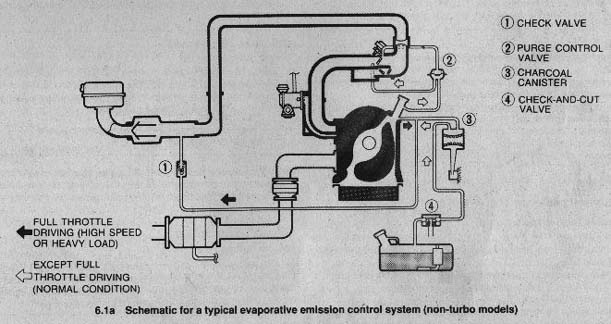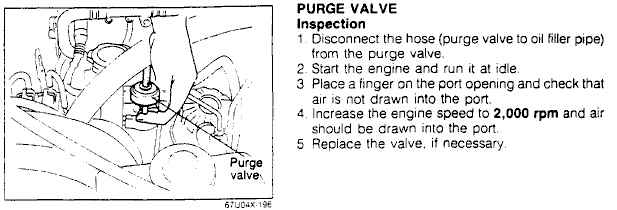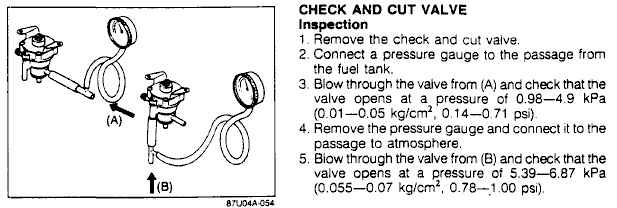CRANKCASE AND EVAPORATIVE EMISSION CONTROL SYSTEM
The crankcase emission control system allows blow-by gases resulting from the combustion process to be drawn into the combustion chamber and burnt under certain conditions. The evaporative emission control system allows fuel vapors that originate in the fuel tank and that are stored in a charcoal canister to be drawn into the combustion chamber and burnt under certain conditions. In the following, I separate the two systems but the evaporative system is connected to the crankcase system (at the oil filler neck).

This above show the schematics for both systems. Note that on a non-turbo model, the line with an in-line check valve (item 1) does not actually exist and should be ignored in the schematics.
CRANKCASE EMISSION CONTROL SYSTEM
In the crankcase emission control system, blow-by gases picked up from a line in the oil filler neck are injected into the combustion chambers via a port located after the throttle plates. The "injection" of blow-by gases is controlled by the purge control valve which is vacuum operated.
The purge control valve opens the path from the oil filler neck to the intake port depending on the pressure differential between the top port and the sum of the two bottom ports. The top port connects to the intake before the throttle plates. The first bottom port connects to the intake after the throttle plates. The second bottom port connects to the oil filler neck under pressure from the blow-by gases. When engine is idling, vacuum after the throttle plates is high, vacuum before the throttle plates is low, and blow-by gas pressure is probably low. This means that the purge valve is closed. When the throttle plates open, the vacuum before the throttle plates increases, the vacuum after the throttle plates decreases, and blow-by gas pressure probably increases. This means the purge valve opens as the throttle is applied. At wide open throttle, the vacuum before the throttle plates is the same as the vacuum after the throttle plates (it is very low) and the blow-by gas pressure is high, this means the purge valve is fully open.
The venting of the crankcase emission control system appears to come from the atmosphere port of the check-and-cut valve (see below). What follows is the FSM test to check for proper operation of the purge control valve.

At idle and low engine speeds, the purge control valve is closed (no vacuum is felt at the port to the oil filler pipe). It does not allow blow-by gases to get injected into the combustion chamber. I think it would be better to have the purge valve slightly open instead of closed but that is just my opinion. At higher engine speeds (above 2,000 rpm), the purge control valve is open. Blow-by gases are admitted into the combustion chambers.
EVAPORATIVE EMISSION CONTROL SYSTEM
The evaporative emission control system prevents fuel vapors from being released into the atmosphere. When the engine is not running and the fuel tank pressure becomes too high (due to fuel evaporation), fuel vapors are drawn into a charcoal canister via the check-and-cut valve and stored. When the engine is running and under certain conditions, the fuel vapors in the canister are purged into the combustion chambers via the purge control valve. The charcoal canister is vented to the atmosphere (to allow a flow of air when a purge vacuum is applied to the canister) via the atmosphere port of the check-and-cut valve. The conditions under which the fuel vapors can be drawn into the combustion chambers are probably the same as the ones for blow-by gases since the path of the fuel vapors is through the oil filler neck. To have vacuum on the charcoal canister and draw the fuel vapors in, the purge valve must be open.

This above is the factory service manual (FSM) test to check for proper operation of the check-and-cut valve. When the pressure in the fuel tank reaches a certain positive value, the path in the valve from the tank to the canister is open allowing fuel vapors to be stored into the canister. When the pressure in the fuel tank is negative (vacuum) due to pumping action, the path from the atmosphere to the fuel tank is open allowing pressure equlibrium (between fuel tank and atmosphere) to be obtained.
Copyright © 2003 - The MAZDA RX-7 86-88 Technical Page - All Rights Reserved